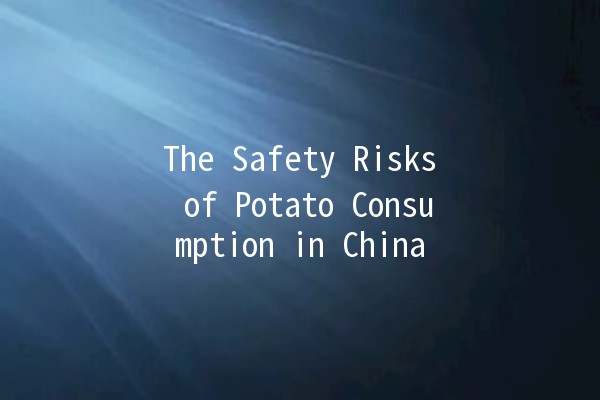Overview of Potato Consumption in China
Potatoes are a staple food in many cultures, enjoyed for their versatility, flavor, and nutritional benefits. In China, potato consumption has been on the rise, making them a significant component of the diet, especially in regions with less rice production. Despite their popularity, there are crucial safety concerns surrounding potato consumption that must be addressed. This article delves into these safety issues, provides practical tips for reducing risks, and explores the implications of improper handling and preparation.
Understanding the Safety Risks Associated with Potatoes

One of the primary concerns regarding potato safety in China is the use of pesticides in agriculture. Many farmers rely heavily on chemical pesticides to protect their crops from pests and diseases. While this can increase yield, it also raises the risk of pesticide residues remaining on the potatoes by the time they reach consumers.
Impact: Prolonged exposure to high levels of pesticides can have serious health implications, including hormone disruption and increased cancer risk.
Potatoes belong to the nightshade family, which can naturally produce a toxic compound called solanine. This compound is primarily found in green or sprouted potatoes and can lead to solanine poisoning when consumed in large quantities.
Symptoms of Solanine Poisoning:
Nausea and vomiting
Abdominal pain
Diarrhea
Headache
Dizziness
In extreme cases, it can result in coma or death.
Like many fresh produce items, potatoes can be contaminated with harmful bacteria during growth, harvest, handling, or preparation. Common bacterial pathogens include Salmonella and E. Coli, which can lead to foodborne illnesses.
Impact: Food poisoning can result in severe gastrointestinal distress and can be especially dangerous for vulnerable populations, such as the elderly or immunocompromised individuals.
Improperly stored potatoes can lead to the growth of harmful bacteria and increased solanine levels. Potatoes should be kept in a cool, dark, and dry place to ensure their safety and quality.
Risks of Improper Storage:
Sprouting increases solanine levels.
Mold and bacterial growth can occur in damp conditions.
Although rare, some individuals may experience allergic reactions to potatoes. Symptoms may include skin rashes, itching, and gastrointestinal issues.
Tips for Safe Potato Consumption
To protect yourself and your family from the safety risks associated with potato consumption, consider the following practical tips:
Explanation: Opting for organic potatoes can significantly reduce your exposure to harmful pesticides. Organic farming practices prohibit the use of synthetic pesticides and fertilizers.
Application Example: When shopping at local markets or grocery stores, specifically look for organic labels on potato products. Engage with local organic farmers at farmers' markets to ensure the produce you are buying is chemicalfree.
Explanation: Washing potatoes thoroughly under running water can help remove dirt, bacteria, and some pesticide residues. Peeling the skin can further reduce exposure to toxins.
Application Example:
Rinse potatoes under water and use a vegetable brush to scrub their skins.
Peel potatoes before cooking, particularly if they have green areas or sprouts.
Explanation: To minimize the risks of solanine and bacterial growth, store potatoes in a cool, dark place with good ventilation.
Application Example: Use a paper bag or a cardboard box and avoid plastic bags, as they can trap moisture. The ideal storage temperature for potatoes is around 4550°F (710°C).
Explanation: Cooking potatoes thoroughly can kill bacteria and reduce solanine levels, especially in green or sprouted potatoes.
Application Example: Ensure that potatoes are boiled, baked, or fried at high temperatures. Avoid consuming raw potatoes or undercooked potato dishes.
Explanation: Knowing the symptoms of solanine poisoning and foodborne illnesses can help you take immediate action in case of exposure.
Application Example: Stay informed about the local outbreaks of foodborne illnesses and monitor your health after consuming potatoes, especially if experiencing unusual symptoms.
Explanation: If you have a known allergy to specific foods, including nightshades, be vigilant about your potato consumption.
Application Example: Keep a food diary to track any allergic reactions after consuming potatoes and consult a healthcare professional if you suspect a food allergy.
Frequently Asked Questions
Many farmers use a variety of pesticides to control pests and diseases, including organophosphates and carbamates. The residues of these chemicals can remain on the potatoes if not washed properly.
Check for signs of spoilage, such as green spots, sprouts, or abnormal texture. If a potato looks bad, feels soft, or has an unusual odor, it is best to discard it.
Cooking can reduce the levels of solanine but will not eliminate it entirely. It is important to avoid eating green or sprouted potatoes altogether, irrespective of cooking.
It is safer to cut away any green spots and a margin around them before cooking the potato. However, if a potato is extensively green or sprouted, it is best to discard it completely.
Under ideal conditions, potatoes can last several weeks to months. However, they should be monitored for sprouting or signs of spoilage regularly.
Baked potatoes are generally healthier than fried potatoes as frying can add unhealthy fats and calories. Baking also preserves more nutrients compared to boiling.
Potatoes can be a delicious and nutritious addition to your diet, but it is essential to remain vigilant about their safety. Being aware of the potential risks and implementing proper handling and preparation techniques can significantly reduce the chance of health issues related to potato consumption. By following these tips, you can enjoy potatoes worryfree while reaping their many health benefits. 🥔✨
This article aims to equip readers with the knowledge they need to make informed decisions about potato consumption and ensure their safety. It provides insights into the risks associated with potatoes and offers practical advice for mitigating these risks. Through safe practices, individuals can enjoy one of the world's most versatile and nutritious foods while minimizing health hazards.